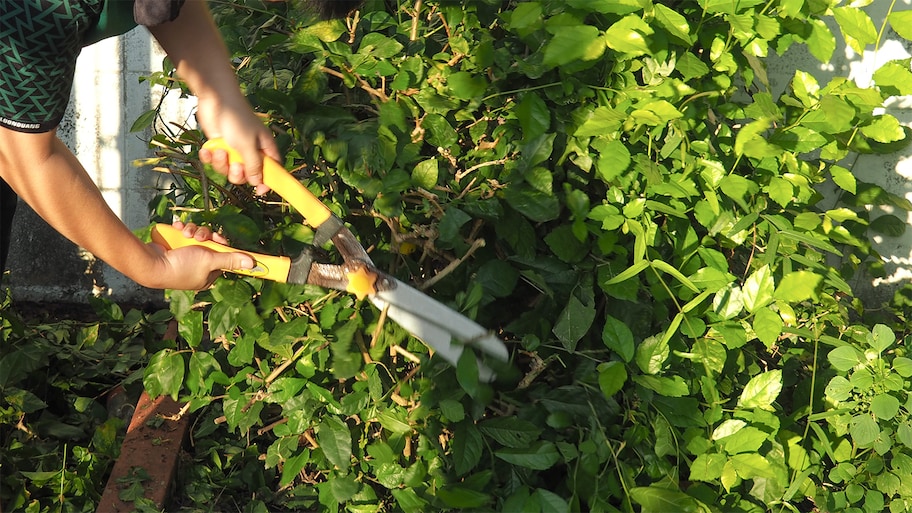How Much Does Bush Removal Cost? [2024 Data]
Normal range: $450 - $1,375
On average, shrub removal costs around $900. Some shrubs have complex root systems, making them more expensive to remove. Large shrubs, such as those over six feet, will also drive the final price up.
If you're tired of trying to tame those overgrown shrubs taking up half your yard, it could be time to consider shrub removal costs.
For professional bush and shrub removal costs, you’ll typically pay about $100 per bush, or $450 and $1,375, depending on the size of the plants and the complexity of the job. Most people pay around $900 for this service.
- Average
- $900
- Low end
- $175
- high end
- $2,675
Bush Removal Cost Calculator
Calculations are based on the average height of a medium-sized bush, which is 3 feet. Calculations rounded to the nearest whole number.
| Quantity | Cost Range | |
|---|---|---|
| Bush Removal | 1 three-foot bush | $40–$75 |
| Removal Labor | 2 hours | $100–$200 |
| Waste Removal | Debris from 1 three-foot bush | $25–$100 |
| Screened Topsoil Replacement | 1 cubic yard | $20 |
| Total | $185–$395 |
How to Calculate Your Bush Removal
To calculate the cost of your bush removal service, follow these steps:
Gauge the size and number of bushes: The first step is to determine the number of bushes you’d like to remove and total their heights.
Get quotes from bush removal companies: Shop around to get estimates from several local bush removal companies. Ask for their hourly rate and determine how long it’ll take for them to complete your job.
Calculate soil replacement needs: Determine how much soil you’ll need to replace post-bush removal by calculating the cubic yards of the area.
Shrub, Hedge, and Bush Removal Cost Factors
Costs for removing shrubs, hedges, and bushes can vary depending on the size, density, root system, soil type, and accessibility. Here’s a breakdown of the different shrub removal cost factors that impact the price of your project.
Size
The cost to remove shrubs and bushes is based on the height of the plants and the complexity of the job. Remember that most contractors have a minimum call-out fee, so even if you only want one or two small bushes removed, they'll likely still bill you for an hour or two of their time to make the job worth their while. Take a look at typical costs per bush based on height.
| Height in Feet | Cost Range | Average Cost |
|---|---|---|
| Small (1–2) | $15–$40 | $25 |
| Medium (2–4) | $40–$75 | $60 |
| Large (4–6) | $75–$150 | $110 |
| Extra large (over 6) | $150–$300 | $225 |
Lone Bushes vs. Clusters
Lone bushes cost less to remove than clusters and hedges, for example, because single, disparate plants are considerably easier to remove than dense clusters.
Stumps and Root System
If you’ve ever bent down and given a shrub a good tug to pull it free from the ground, you may have been surprised by how challenging—or easy—it is to remove the plant. The complexity of this part of the job all comes down to the root system. Some species of plants have a deeper root system than others and will take longer and cost more to remove than shrubs with a shallow root system.
On the other hand, there are a few options for stump removal. You can grind a tree stump, which costs an average of $320, grub out a tree stump, or remove it with a chainsaw.
Accessibility
A flatter terrain close to the road makes for a simpler and less costly price tag than a rocky, steep, or marshy terrain far away from access points. Lugging shrubs and root systems back and forth from a long distance adds time to the job, which means you’ll often end up paying a professional more to remove such plants.
Waste Removal
Along with labor (which makes up the bulk of the cost for bush removal), you'll also need to account for removal and disposal of the waste, which costs between $25 and $100 per bush, depending on the volume of waste and how far the contractor has to haul it.
Soil Type
The type of soil you have also plays a role in how easy it is to remove shrubs from your property. Thicker and denser soil, like clay, can prove to be more challenging to pull roots free than lighter soil, like sand. Rocky soil may be easier for shrub removal, or it can prove to be more difficult depending on the size of the rocks and whether or not an established root system is hard to dig out. A pro can assess your soil and give you recommendations for the best removal method.
Soil Replacement
With large removals, you'll be left with significant holes, so you'll also need to pay for soil replacement. Screened topsoil costs around $20 per cubic yard, but you can pay as much as $180 per cubic yard for soil replacement. How much you'll pay depends on the type and quality of the soil, how much you need, and whether you have to pay extra for delivery. You may also want to hire a landscaper to help rejuvenate your garden at this point.
Location
Shrubs in hard-to-reach areas, close to buildings, or surrounded by obstacles may require additional effort or precautions, increasing the overall expense of removal. For instance, shrub removal in backyards with limited access or tight areas surrounded by structures may require specialized equipment or manual labor, resulting in higher costs. Along with that, the presence of utilities, such as power lines, underground pipes, or irrigation systems, may call for additional precautions during removal to avoid damage, further influencing the cost.
Additional Project Costs
Here are some additional costs to consider when planning your overall budget for shrub removal.
Shrub, Bush, and Hedge Trimming
Pruning hedges and shrubs costs an average of $450 to $1,420. Trimming and maintaining shrubs, bushes, and hedges is essential for promoting healthy growth, and maintaining a neat appearance in your landscape. The cost of trimming will depend on the number of shrubs, their size, and the complexity of their growth patterns. Simple shaping or light pruning may be relatively inexpensive, but more extensive or specialized trimming techniques may incur higher costs.
Tree Trimming
Pruning a tree costs an average of $75 for a small sapling to $1,500 or more if the tree’s height surpasses 60 feet. The cost of tree trimming varies based on the size, height, and condition of the trees, as well as the complexity of the trimming required. Removing dead or overhanging branches, shaping the tree’s canopy, or conducting crown thinning are common tree trimming tasks that can impact the overall cost.
Tree Removal
Tree removal costs $750 on average, but prices can range anywhere from $200 to $2,000. If you’re unsure whether to remove a tree, know that tree removal is often necessary when a tree is dead, diseased, hazardous, or no longer desirable in a particular location. The cost of tree removal depends on factors such as the tree's height, diameter, accessibility, and proximity to structures or utilities. Larger trees or those located in difficult-to-access spots may require specialized equipment and professional expertise, leading to higher removal costs.
Grass Installation
The cost to lay sod typically ranges between $1,100 and $3,000, while seeding or reseeding a lawn costs anywhere from $450 to $1,700. While pricier, sod installation offers instant results. Seeding or reseeding is more budget-friendly, but it can take as long as two months before the lawn is full enough to mow.
Flower Bed Installation
Installing flower beds professionally can cost anywhere from $800 to $3,000 or more. The cost of flower bed installation will depend on the size of the beds, the selection of plants and flowers, and any additional features such as edging or mulching. You can opt to plant your own flowers from your local nursery or garden center to keep this project more budget-friendly.
DIY vs. Hiring a Pro
You can make big savings by removing shrubs and bushes yourself, but there are a few caveats. The first is the labor involved. Digging up and removing shrubs and bushes, even small ones, is really hard work. It's labor-intensive, time-consuming, and involves a lot of strength. If that's not your forte, you may decide the cost of hiring professional gardeners is well worth it.
"Many times, old and established shrubs require the use of equipment such as skid loaders to do the job," says Dudley.
There's a certain amount of skill involved, too. You've got to do a thorough job and make sure you get as much of the root system out as possible; otherwise, the plant you worked so diligently to get rid of could grow back in a year or two.
Remember that you'll need to dispose of the waste, which requires you to either run it through a shredder and use it as mulch or take it to a yard waste disposal facility.
If removing the bushes has left some craters in your yard, and you're doing the job entirely by yourself, you'll also need to haul in topsoil. So, unless you already have a large vehicle capable of hauling big volumes of soil, you'd need to hire one or pay for the soil to be delivered. Either way, once it arrives, you'll have to move it to fill in the bush craters by hand, which is even more toil. So yes, the monetary cost to remove shrubs and bushes yourself is much less, but there's a high cost in terms of physical labor and time.
Cost to Remove Shrubs Yourself vs. Hiring a Pro
Hiring a landscaping company near you may cost you $50 to $100 or more per hour of work than if you were to do it yourself. Some landscaping professionals will charge by the bush, which can cost anywhere from $6 to $15 each. Keep in mind that you’ll also want to factor in local hauling and dump services, which can tack on $25 to $100 extra to take all of those shrubs far, far away. However, this cost can be worth it, especially if you don’t know where to start or if you’re dealing with very large bushes and shrubs.
How to Save Money on Bush or Shrub Removal

If you don't want to tackle the whole job by yourself, but you want to save money where you can, there are some things you can do to reduce the project cost.
Clear the area around the bushes yourself.
Prepare the ground by removing the top layer of turf and debris. You can also finish the project yourself by bringing in soil and planting the area.
While hauling soil is labor-intensive, sowing grass seed is fairly easy. If you're a keen gardener and often use mulch, you can save money in multiple ways by shredding the bushes yourself.
Compare price quotes and services from several reputable landscaping companies to find the most cost-effective option for your removal needs.
Consider scheduling the shrub removal during the off-peak seasons for landscaping services to potentially receive discounted services.
If you have multiple shrubs or bushes to remove, consider grouping them together and having them removed in a single project—many landscapers offer discounts for multiple services performed on the same visit.
If the shrub is still healthy and aesthetically pleasing, consider trimming it instead of completely removing it.
Frequently Asked Questions
The easiest way to remove bushes is first to cut the bush down. You may need to use a handsaw, pruning shears, or a chainsaw for thicker branches. Once you’ve removed most of the branches, you can then cut the base of the shrub as low to the ground as you can get. Then, with a shovel, dig around until you expose the roots. Dig out the roots, being careful not to leave any roots in the soil.
A bush is similar to a shrub and a hedge, but the difference between these plants is that bushes have branches at ground level. A shrub is a small woody plant. A hedge is a line of bushes or shrubs that are trimmed to look like one long continuous row of plants that are usually designed for privacy.
While you can leave roots in the ground, if you don’t want the shrub to regrow again over time, it’s best not to leave any roots behind. Ensure you remove as much of the shrub as possible, including the root ball and any main roots you can see, to prevent new growth. Some gardeners opt for using a chemical treatment to prevent the stump from growing back, but this can kill beneficial microorganisms living in your soil.
To remove a shrub, start by cutting back the shrub using pruning shears, loppers, or a chainsaw. Next, dig around the base of the shrub with a pointed shovel to expose its root system. Then, use a shovel or a mattock to loosen the roots, making it easier to pull or lift the shrub from the ground. For larger shrubs or stubborn root systems, attaching a chain or strap to the base and using a vehicle to pull it out can be effective. Ensure proper disposal of the shrub and its debris following local waste disposal guidelines.
The cost to remove all bushes around a house can vary widely based on the size and number of bushes, their location, and the complexity of the removal process. Smaller properties with fewer or smaller bushes may cost less, while larger properties with numerous or larger bushes will cost more. Additionally, if any bushes are located in hard-to-reach areas, you’ll likely pay additional labor costs. To get an accurate cost estimate, it’s always a good idea to obtain quotes from local landscaping or tree removal services based on the specific needs of your property.

